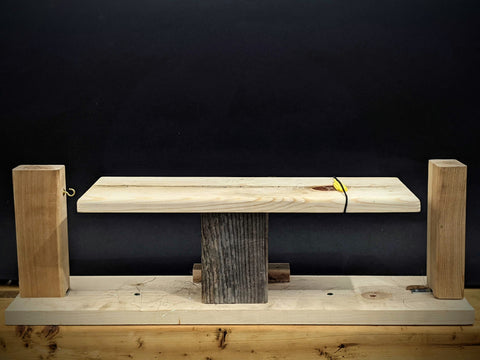If you've tied with dubbing brushes, and perhaps have made the the leap to making your own brushes, the next step down the rabbit hole is to learn to spin Bucktail brushes. In this journal entry, we'll outline the basic steps to create your own bucktail brushes. Start with a brushmaking table, see our guide here for an example of a DIY version.

Other tools you'll need:


1) Each brushtable will work slightly differently, so use your table as you normally would. In our example, we cut a single strand of braided line, fold in half and tie a loop knot to attach to one end of the table. Apply a thin coating of dubbing wax.

2) Secure one end of the braided line down the center of the brushtable. Pictured above, we've ingeniously fashioned a hair tie and some beetle foam into a nice line holder. Your table might have another hook on this end

3) Working in pinches, trim Bucktail and brush out the underfur. Lay down the fibers so the butt ends lay 1/4" over the secured braided line.
Here's where your creativity and technique comes in. Play with color blends, alternating color, adding flash.or other material as you see fit. W&M brushes have their longest fibers on one end, and taper shorter toward the other. To achieve a buford style head, use short trimmed Bucktail from the base of the tail or experiment with body or belly hair.

Continue to lay down fibers across the braided line. Once you reach the end of the brush table, take the loose end of the braided line and sandwich it over the fibers and tie a loop knot with the bottom strand of braided line.

4) Spin the brush. Without disturbing the brush table or moving the fibers, loop the braided line onto a hook inserted into a drill (or the spinning wheel if your brush table has one), and with as much tension on the braided line as possible, slowly start to spin the brush. As the first few turns go around, gently lift the brush upward and remove the horizontal table. You should be able to hold the braided line under tension and if you continue to spin, the bucktail fibers will hold in place.

Spin the brush quickly until all the fibers are tightly wound between the braided line. Be careful not to over spin the brush, as the Bucktail could cut through the line, or the fibers themselves may split. Remove the brush from the table and tie an overhand knot in the long end of the braided line to help keep the brush from coming unraveled.

You're now well on your way to tying with Bucktail brushes! Spinning these large brushes takes practice, and one key is maintain really high tension on the braided line when you spin it. But once the basic spinning is mastered, the possibilities are endless for creating beautiful color blends, perfect tapers and unique predator flies.
For tips on how to use these brushes in big predator patterns, head to this post on the classic Buford.
Pick up materials, feathers, or check out Weights & Measures brushes right here.
